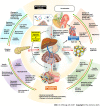Periodontal treatment and microbiome-targeted therapy in management of periodontitis-related nonalcoholic fatty liver disease with oral and gut dysbiosis
- PMID: 36844143
- PMCID: PMC9950865
- DOI: 10.3748/wjg.v29.i6.967
Periodontal treatment and microbiome-targeted therapy in management of periodontitis-related nonalcoholic fatty liver disease with oral and gut dysbiosis
Abstract
A growing body of evidence from multiple areas proposes that periodontal disease, accompanied by oral inflammation and pathological changes in the microbiome, induces gut dysbiosis and is involved in the pathogenesis of nonalcoholic fatty liver disease (NAFLD). A subgroup of NAFLD patients have a severely progressive form, namely nonalcoholic steatohepatitis (NASH), which is characterized by histological findings that include inflammatory cell infiltration and fibrosis. NASH has a high risk of further progression to cirrhosis and hepatocellular carcinoma. The oral microbiota may serve as an endogenous reservoir for gut microbiota, and transport of oral bacteria through the gastro-intestinal tract can set up a gut microbiome dysbiosis. Gut dysbiosis increases the production of potential hepatotoxins, including lipopolysaccharide, ethanol, and other volatile organic compounds such as acetone, phenol and cyclopentane. Moreover, gut dysbiosis increases intestinal permeability by disrupting tight junctions in the intestinal wall, leading to enhanced translocation of these hepatotoxins and enteric bacteria into the liver through the portal circulation. In particular, many animal studies support that oral administration of Porphyromonas gingivalis, a typical periodontopathic bacterium, induces disturbances in glycolipid metabolism and inflammation in the liver with gut dysbiosis. NAFLD, also known as the hepatic phenotype of metabolic syndrome, is strongly associated with metabolic complications, such as obesity and diabetes. Periodontal disease also has a bidirectional relationship with metabolic syndrome, and both diseases may induce oral and gut microbiome dysbiosis with insulin resistance and systemic chronic inflammation cooperatively. In this review, we will describe the link between periodontal disease and NAFLD with a focus on basic, epidemiological, and clinical studies, and discuss potential mechanisms linking the two diseases and possible therapeutic approaches focused on the microbiome. In conclusion, it is presumed that the pathogenesis of NAFLD involves a complex crosstalk between periodontal disease, gut microbiota, and metabolic syndrome. Thus, the conventional periodontal treatment and novel microbiome-targeted therapies that include probiotics, prebiotics and bacteriocins would hold great promise for preventing the onset and progression of NAFLD and subsequent complications in patients with periodontal disease.
Keywords: Dysbiosis; Metabolic syndrome; Microbiota; Nonalcoholic fatty liver disease; Periodontal disease; Probiotics.
©The Author(s) 2023. Published by Baishideng Publishing Group Inc. All rights reserved.
Conflict of interest statement
Conflict-of-interest statement: All the authors report no relevant conflicts of interest for this article.
Figures


Similar articles
-
The current findings on the gut-liver axis and the molecular basis of NAFLD/NASH associated with gut microbiome dysbiosis.Naunyn Schmiedebergs Arch Pharmacol. 2025 Apr 9. doi: 10.1007/s00210-025-04069-z. Online ahead of print. Naunyn Schmiedebergs Arch Pharmacol. 2025. PMID: 40202676 Review.
-
Periodontal disease-related nonalcoholic fatty liver disease and nonalcoholic steatohepatitis: An emerging concept of oral-liver axis.Periodontol 2000. 2021 Oct;87(1):204-240. doi: 10.1111/prd.12387. Periodontol 2000. 2021. PMID: 34463983 Free PMC article. Review.
-
Oral and Gut Microbial Dysbiosis and Non-alcoholic Fatty Liver Disease: The Central Role of Porphyromonas gingivalis.Front Med (Lausanne). 2022 Mar 2;9:822190. doi: 10.3389/fmed.2022.822190. eCollection 2022. Front Med (Lausanne). 2022. PMID: 35308549 Free PMC article. Review.
-
The severity of nonalcoholic fatty liver disease is associated with gut dysbiosis and shift in the metabolic function of the gut microbiota.Hepatology. 2016 Mar;63(3):764-75. doi: 10.1002/hep.28356. Epub 2016 Jan 13. Hepatology. 2016. PMID: 26600078 Free PMC article.
-
Understanding the Role of the Gut Microbiome and Microbial Metabolites in Non-Alcoholic Fatty Liver Disease: Current Evidence and Perspectives.Biomolecules. 2021 Dec 31;12(1):56. doi: 10.3390/biom12010056. Biomolecules. 2021. PMID: 35053205 Free PMC article. Review.
Cited by
-
Heterologous expression and antimicrobial potential of class II bacteriocins.Gut Microbes. 2024 Jan-Dec;16(1):2369338. doi: 10.1080/19490976.2024.2369338. Epub 2024 Jun 20. Gut Microbes. 2024. PMID: 38899682 Free PMC article.
-
The gut microbiota: an emerging modulator of drug resistance in hepatocellular carcinoma.Gut Microbes. 2025 Dec;17(1):2473504. doi: 10.1080/19490976.2025.2473504. Epub 2025 Mar 5. Gut Microbes. 2025. PMID: 40042184 Free PMC article. Review.
-
Periodontal Treatment to Improve General Health and Manage Systemic Diseases.Adv Exp Med Biol. 2025;1472:245-260. doi: 10.1007/978-3-031-79146-8_15. Adv Exp Med Biol. 2025. PMID: 40111696 Review.
-
Oral Pathogenic Bacteria and the Oral-Gut-Liver Axis: A New Understanding of Chronic Liver Diseases.Diagnostics (Basel). 2023 Oct 26;13(21):3324. doi: 10.3390/diagnostics13213324. Diagnostics (Basel). 2023. PMID: 37958220 Free PMC article. Review.
-
Recent advances in therapeutic probiotics: insights from human trials.Clin Microbiol Rev. 2025 Jun 12;38(2):e0024024. doi: 10.1128/cmr.00240-24. Epub 2025 Apr 22. Clin Microbiol Rev. 2025. PMID: 40261032 Review.
References
-
- Page RC. The pathobiology of periodontal diseases may affect systemic diseases: inversion of a paradigm. Ann Periodontol . 1998;3:108–120. - PubMed
-
- Williams RC. Periodontal disease. N Engl J Med . 1990;322:373–382. - PubMed
-
- Socransky SS, Haffajee AD, Cugini MA, Smith C, Kent RL, Jr Microbial complexes in subgingival plaque. J Clin Periodontol . 1998;25:134–144. - PubMed
-
- Socransky SS, Haffajee AD. Dental biofilms: difficult therapeutic targets. Periodontol 2000 . 2002;28:12–55. - PubMed

